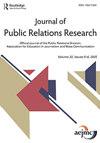A Test of a Dual Model of Positive and Negative EORs: Dialogic Employee Communication Perceptions Related to Employee-Organization Relationships and Employee Megaphoning Intentions1
IF 4.4
2区 文学
Q1 COMMUNICATION
引用次数: 0
Abstract
ABSTRACT This study investigated how employees’ perceptions of an organization’s dialogic employee communication influence their evaluations of their positive and negative relationships with the organization. The study further examined how employees’ relationship assessments could drive their intentions for positive and negative megaphoning about their organizations. To test the differentiating effects of dialogic employee communication on positive and negative employee-organization relationships (EORs) and, subsequently, employee megaphoning intentions, we used a dual measure with the positive and the negative EORs. The online survey of 527 full-time U.S. employees showed that dialogic employee communication – particularly mutuality orientation – distinctively influenced the employees’ EOR assessments. The survey results also showed that stronger and more-positive EORs led to increased positive megaphoning intentions, and that stronger and more-negative EORs led to increased negative megaphoning intentions. This study found that positive EOR mediated the links between dialogic employee communication and both positive and negative intentions, but that negative EOR mediated only the link between dialogic employee communication and the negative megaphoning intention.正EORs和负EORs双重模型的检验:与员工组织关系和员工Megaphoning意向相关的对话员工沟通感知1
摘要本研究调查了员工对组织对话式员工沟通的感知如何影响他们对与组织的积极和消极关系的评价。该研究进一步考察了员工的关系评估如何推动他们对组织进行积极和消极的宣传。为了测试对话式员工沟通对积极和消极的员工组织关系(EOR)以及随后对员工打电话意向的区分作用,我们使用了积极和消极EOR的双重测量。这项针对527名全职美国员工的在线调查显示,对话式的员工沟通——尤其是相互导向——显著影响了员工的EOR评估。调查结果还显示,更强、更积极的EOR导致积极的扩音器意图增加,更强、更多的消极EOR导致消极扩音器意图增加。本研究发现,积极的EOR介导了对话式员工沟通与积极和消极意图之间的联系,而消极的EOR仅介导了员工对话式沟通与消极的扩音器意图之间的关系。
本文章由计算机程序翻译,如有差异,请以英文原文为准。
求助全文
约1分钟内获得全文
求助全文

 求助内容:
求助内容: 应助结果提醒方式:
应助结果提醒方式:


